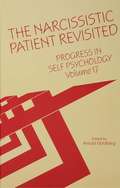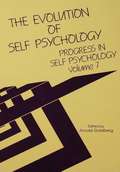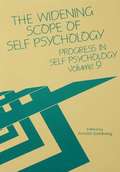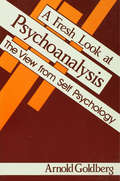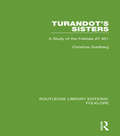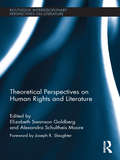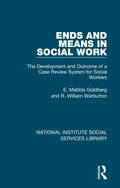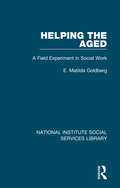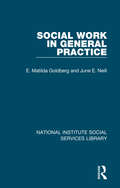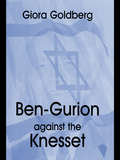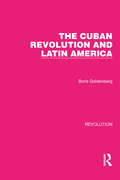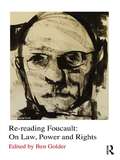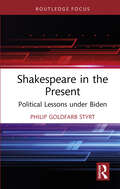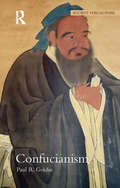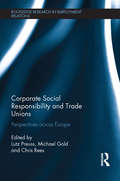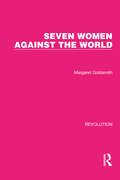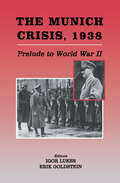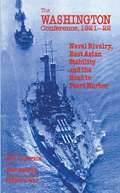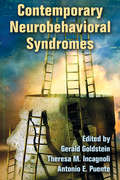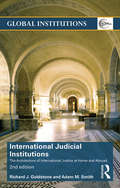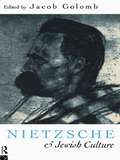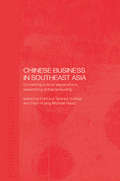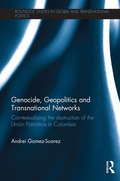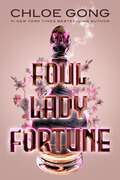Special Collections
Benetech’s Global Certified Accessible Titles
Description: Benetech’s GCA program is the first independent third-party EPUB certification to verify ebook accessibility. By creating content that is born accessible, publishers can meet the needs of all readers. Learn more: https://bornaccessible.benetech.org/
- Table View
- List View
Progress in Self Psychology, V. 17
by Arnold GoldbergVolume 17 of Progress in Self Psychology, The Narcissistic Patient Revisited, begins with the next installment of Strozier's "From the Kohut Archives": first publication of a fragment by Kohut on social class and self-formation and of four letters from his final decade. Taken together, Hazel Ipp's richly textured "Case of Gayle" and the commentaries that it elicits amount to a searching reexamination of narcissistic pathology and the therapeutic process. This illuminating reprise on the clinical phenomenology Kohut associated with "narcissistic personality disorder" accounts for the volume title. The ability of modern self psychology to integrate central concepts from other theories gains expression in Teicholz's proposal for a two-tiered theory of intersubjectivity, in Brownlow's examination of the fear of intimacy, and in Garfield's model for the treatment of psychosis. The social relevance of self psychology comes to the fore in an examination of the experience of adopted children and an inquiry into the roots of mystical experience, both of which concern the ubiquity of the human longing for an idealized parent imago. Among contributions that bring self-psychological ideas to bear on the arts, Frank Lachmann's provocative "Words and Music," which links the history of music to the history of psychoanalytic thought in the quest for universal substrata of psychological experience, deserves special mention. Annette Lachmann's consideration of empathic failure among the characters in Shakespeare's Othello and Silverstein's reflections on Schubert's self-states and selfobject needs in relation to the specific poems set to music in his Lieder round out a collection as richly broad based as the field of self psychology itself.
Progress in Self Psychology, V. 7
by Arnold GoldbergA special section of papers on the evolution, current status, and future development of self psychology highlights The Evolution of Self Psychology, volume 7 of the Progress in Self Psychology series. A critical review of recent books by Basch, Goldberg, and Stolorow et al. is part of this endeavor. Theoretical contributions to Volume 7 examine self psychology in relation to object relations theory and reconsider the relationship of psychotherapy to psychoanalysis. Clinical contributions deal with an intersubjective perspective on countertransference, the trauma of incest, and envy in the transference.
Progress in Self Psychology, V. 9
by Arnold GoldbergThe Widening Scope of Self Psychology is a watershed in the self-psychological literature, being a contemporary reprise on several major clinical themes through which self psychology, from its inception, has articulated its challenge to traditional psychoanalytic thinking. The volume opens with original papers on interpretation by eminent theorists in the self-psychological tradition, followed by a series of case studies and clinically grounded commentaries bearing on issues of sex and gender as they enter into analysis. Two thoughtful reexaminations of the meaning and treatment challenges of chronic rage are followed by clinical papers that focus, respectively, on mourning, alter ego transferences, resistance to change, and pathological identification. Applied analytic contributions and a review of Goldberg's The Prisonhouse of Psychoanalysis round out a collection that testifies not only to the widening scope of self psychology, but to its deepening insights as well.
A Fresh Look at Psychoanalysis
by Arnold I. GoldbergGoldberg uses the questions posed by self psychology as point of entry to a thoughtful consideration of issues with which every clinician wrestles: the scientific status analysis, the relationships among its competing theories, the role of empathy in analytic method, and the place of the "self" in the analyst's explanatory strategies. Clinical chapters show how the notion of the self can provide organizing insights into little-appreciated character structures.
Turandot's Sisters
by Christine GoldbergThe central tale studied in Turandot’s Sisters, first published in 1993, is The Princess Who Can Not Solve the Riddle, AT 851. Other wisdom tales are surveyed to show that they are separate from the riddle tales in material and in spirit. Customs and beliefs concerning riddling and riddle contests are examined to see what motifs from the tales are taken from reality, leaving the rest to be either fantasy motifs or stylistic traits. The central tale AT 851 is analysed in detail to exhibit its obligatory and optional elements, a wealth of possibilities that enables it to adapt to a range of moods and to express a variety of ideas.
Theoretical Perspectives on Human Rights and Literature
by Joseph R. Slaughter and Alexandra Schultheis Moore and Elizabeth Swanson GoldbergWhat can literary theory reveal about discourses and practices of human rights, and how can human rights frameworks help to make sense of literature? How have human rights concerns shaped the literary marketplace, and how can literature impact human rights concerns? Essays in this volume theorize how both literature and reading literarily can shape understanding of human rights in productive ways. Contributors to Theoretical Perspectives on Human Rights and Literature provide a shared history of modern literature and rights; theorize how trauma, ethics, subjectivity, and witnessing shape representations of human rights violations and claims in literary texts across a range of genres (including poetry, the novel, graphic narrative, short story, testimonial, and religious fables); and consider a range of civil, political, social, economic, and cultural rights and their representations. The authors reflect on the imperial and colonial histories of human rights as well as the cynical mobilization of human rights discourses in the name of war, violence, and repression; at the same time, they take seriously Gayatri Spivak’s exhortation that human rights is something that we "cannot not want," exploring the central function of storytelling at the heart of all human rights claims, discourses, and policies.
Ends and Means in Social Work
by E. Matilda Goldberg and R. William WarburtonOriginally published in 1979, Ends and Means in Social Work was the first book to provide research-based evidence on what social workers actually do, what they were aiming to achieve, and what sense their activities made, both in terms of their own subjective perspectives and those of their clients. The authors describe and analyse a series of surveys and action studies based on a year’s referrals and the long-term clientele of an area office. They aimed first to find out what the clients thought of and expected from the newly reorganised social services, and how social workers saw the changes and their new responsibilities. The second aim was to discover how social work skills and other resources were being used to meet different client needs. Third, the research was designed to enable social workers, by developing a new monitoring tool, the Case Review System, to become more explicit about both the ends and means of their activities. Widespread interest had been aroused by the Case Review System. It had raised intriguing questions about who gets what and why. On an individual level, the Case Review System can enable social workers to evaluate their practice by comparing plan with achievement; as an educational tool it can assist supervision; as a management tool it can provide aggregated data on client characteristics, the use of resources, and outcomes; as a research tool it can answer questions on the relationships between client characteristics, problems and social work practice, and provide longitudinal data on client careers. It is in response to insistent demands for a rounded account of this research project and its results that this book has been written. It endeavours to bring together all the aspects of the specific research studies and to discuss their wider implications for the organisation of the personal social services. Particularly valuable for students and practitioners alike will be the concluding discussion in which the evidence which emerged about the use of social work resources is subjected to critical review. Questions are raised about the current deployment of social work skills, and suggestions are made about how these skills might be redeployed, tasks defined more realistically, and how statutory functions could mesh more easily with voluntary activities.
Helping the Aged
by E. Matilda GoldbergIn 1970 social workers were in great demand and their numbers were growing. At the same time questions were asked on both sides of the Atlantic about the methods they employed, their objectives and the effectiveness of their efforts. Previous studies undertaken in the United States to test the effectiveness of social casework had led to intense controversy between researchers and practitioners. Originally published in 1970, the field experiment described in this book was the first British attempt to assess the effectiveness of social work. A team led by a social worker, including a physician and a statistician, assessed the social and medical conditions of 300 aged applicants to a local authority welfare department and determined their needs for help. Half of these old people were randomly selected to receive help from trained caseworkers; the other half, also randomly chosen, remained with experienced local authority welfare officers without professional training. The social and medical conditions of the surviving clients were reassessed after an interval. Both sets of social workers had achieved much in alleviating practical needs. But the trained workers brought about more change in their clients’ activities, feelings and attitudes. The opinions of the old people about the services they received and the social workers who had carried them out added another dimension to this pioneer study which contributed to research methodology, helped to clarify operational goals in social work, made a beginning in measuring social work effort and enlarged our meagre knowledge of social work with old people at the time.
Social Work in General Practice
by E. Matilda Goldberg and June E. NeillIn the early 1970s general practitioners were well aware that they were being asked to deal not only with physical illness in their patients but also with the stresses relating to social and emotional problems. Increasingly often they were working together with health visitors and social workers in attempting to respond more effectively to these demands. Originally published in 1972, this study describes the attachment of a social worker to a group general medical practice in London, indicating why, for all social groups, the general practice is an appropriate point at which psychosocial problems may be identified and treated. The authors describe the nature and range of patients’ problems that come to light in the consulting room; how patients present their problems to the social worker; and the kind of help the social worker is able to offer. They explore the extent to which the general practice setting provides opportunities for preventive therapy and further describe how social work in general practice can most effectively be related to existing social services in the community, particularly to the reorganised personal social services. Their findings are supported throughout by illuminating case studies. The book also discusses the integration of the social worker into the general practice team, the problems that have to be solved and the mutual enlightenment that results. This emerges as an extremely encouraging and instructive experiment, which will immediately interest social service departments and social workers, doctors and nurses, both students and those in practice. The wide spectrum of social problems encountered and dealt with by the social worker in a general practice make it a particularly stimulating account.
Ben-Gurion Against the Knesset
by Giora GoldbergThe power struggle between Ben-Gurion and the Knesset was not primarily concerned with who should hold the reins of power, but with the ideals that should lie behind government. Ben-Gurion did not think that the Knesset had the moral backbone required at a historic turning-point in Israeli history, when the character of the nation was being developed; although he conceded that it was capable of dealing with the more mundane administrative tasks. He therefore denied the Knesset the right to take part in the policy-making process, caused a decline in the support of the elite and the general public, encouraged partisanship, and endeavored to reduce competitiveness. Ben-Gurion was so dismissive of the Knesset and its members, that he would not even attend parties at which Knesset members were being given awards.
The Cuban Revolution and Latin America
by Boris GoldenbergThis book, first published in 1965, is a scrupulously fair study of the origins and evolution of Castroism and an assessment of the impact of the Cuban revolution and of Castro’s subsequent domestic and foreign policies on the rest of Latin America. In this analysis it takes into account the great differences – social, economic and cultural – between the countries of the area and looks at the foreign policies of Latin American countries as well as the United States and the role of international Communism.
Re-reading Foucault
by Ben GolderLaw, Rights and Power: Re-Reading Foucault is the first collection in English to fully address the relevance of Foucault’s thought for law. Michel Foucault is the best known and most cited of the late twentieth-century’s ‘theory’ academics. His work continues to animate a range of different critical work across intellectual disciplines in the arts, humanities and social sciences. There has, however, been relatively little examination of the legal implications and applications of Foucault’s work. This book fills that gap, providing an in-depth analysis of Foucault’s thought as it pertains to the crucial questions of law, government and rights. This collection engages with key legal themes as they emerge, both in Foucault’s work and in the contemporary scholarship that surrounds it. These include: the opposition between ‘law’ and ‘the juridical’; legal ways of organising and processing knowledge; sovereignty; punishment; bio-politics and governmentality; security; resistance; and, judgment. Including contributions from acknowledged experts on Foucault’s work, as well as pieces by younger scholars, Law, Rights and Power: Re-Reading Foucault will be of considerable interest across a range of disciplines, including law, sociology, criminology, international relations, political theory, and philosophy.
Shakespeare in the Present
by Philip Goldfarb StyrtShakespeare in the Present: Political Lessons under Biden is the first case study in applying the lessons of Shakespeare’s plays to post-Trump America. It looks at American politics through the lens of Shakespeare, not simply equating figures in the contemporary world to Shakespearean characters, but showing how the broader conditions of Shakespeare’s imagined worlds reflect and inform our own. Clearly written, in a direct and engaging style, it shows that reading Shakespeare with our contemporary Washington in mind can enrich our understanding of both his works and our world. Shakespeare wrote for his own time, but we always read him in our present. As such, the way we read him now is always affected by our own understanding of our own political world. This book provides quick critical analyses of Shakespeare’s plays and contemporary American politics while serving as an introduction for undergraduates and general readers to this kind of topical, presentist criticism of Shakespeare.
Confucianism
by Paul R. Goldin"Confucianism" presents the history and salient tenets of Confucian thought, and discusses its viability, from both a social and a philosophical point of view, in the modern world. Despite most of the major Confucian texts having been translated into English, there remains a surprising lack of straightforward textbooks on Confucian philosophy in any Western language. Those that do exist are often oriented from the point of view of Western philosophy - or, worse, a peculiar school of thought within Western philosophy - and advance correspondingly skewed interpretations of Confucianism. This book seeks to rectify this situation. It guides readers through the philosophies of the three major classical Confucians: Confucius (551-479 BCE), Mencius (372-289 BCE?) and Xunzi (fl. 3rd cent. BCE), and concludes with an overview of later Confucian revivals and the standing of Confucianism today.
Corporate Social Responsibility and Trade Unions
by Chris Rees and Michael Gold and Lutz PreussGrowing interest in corporate social responsibility (CSR) has focused attention on the relationship between businesses and key stakeholders, such as NGOs and local communities. Curiously, however, commentators on CSR rarely discuss the role of trade unions, while commentators on employment relations seldom engage with CSR. This situation is all the more remarkable since unions are a critically important social actor and have traditionally played a prominent role in defending the interests of one key stakeholder in the company, the employee. Written by dedicated experts in their field, this book addresses a key gap in the literature on both CSR and employment relations, namely trade union policies towards CSR, as well as union engagement with particular CSR initiatives and the challenges they face in doing so. The research covers eleven European countries which, when taken together, constitute a representative sample of industrial relations structures across the continent. This book will be essential reading for scholars, students and practitioners of international business, employment relations, public policy and CSR. Its foreword is written by Philippe Pochet and Maria Jepsen, Directors of the European Trade Union Institute in Brussels.
Seven Women Against the World
by Margaret GoldsmithThis book, first published in 1935, examines the lives of seven revolutionary women: Charlotte Corday, Théroigne de Méricourt, Flora Tristan, Louise Michel, Vera Figner, Emma Goldman and Rosa Luxemburg. The revolutionary impulses of these remarkable women emerge as the natural result of the historical associations of their age, but the author concludes that some sacrifices were made in vain because there was no strong revolutionary movement behind them. This book is a key analysis of the reasons behind the revolt of these women against their systems of society, and why some of them thought it worth while to die if necessary for the principles in which they believed.
The Munich Crisis, 1938
by Erik Goldstein and Igor LukesMost of the works on the crises of the 1930s and especially the Munich Agreement in 1938 were written when it was virtually impossible to gain access to the relevant archive collections on both sides of the Iron Curtain. This text studies the Czechoslovak-German crisis and its impact from previously neglected perspectives and celebrates the post-Cold War openness by bringing in new evidence from hitherto inaccessible archives.
The Washington Conference, 1921-22
by Erik Goldstein and John MaurerThe Washington Conference regulated the inter-war naval race between the world powers. In the era when it was still believed that battleships were the epitome of naval power and a sign of a country's strength, this conference led to limitations on the building of such weapons by the naval powers of Britain, the USA and Japan. This collection of essays deals with many aspects of the conference; the factors that caused it, the interests of the participating nations both present and future, and the results.
Contemporary Neurobehavioral Syndromes
by Gerald Goldstein and Theresa M. Incagnoli and Antonio E. PuenteDuring the twentieth century, new neurobehavioral diseases appeared or were described for the first time. Exposure to certain toxins or noxious environments, for example, produced illnesses that did not exist before the twentieth century. In addition, established illnesses were reconceptualized with regard to their cause or neurobiological basis. Autism, for instance, was described for the first time during the twentieth century and may not have existed previously. Its cause was subsequently reconceptualized from a disorder related to inadequate parenting, to a brain disorder with possible genetic causes. These major new and reconceptualized disorders are reviewed in this book with regard to their neurocognitive characteristics, causes, and outcome. Disorders covered include ADHD in adults, Lewy Body Dementia, autism, multiple chemical sensitivity, deployment syndromes found in veterans of the Persian Gulf and Afghanistan wars, effects of low birth weight, neurobehavioral respiratory disorders, PTSD, and comorbid disorders such as depression and brain injury. The expert reviews of these disorders give balanced coverage of the ongoing and often controversial research findings that continue to generate much professional and public interest. This volume provides an essential resource for researchers, instructors, and clinicians in the fields of neuropsychology, psychiatry, behavioral neurology, neuroscience, toxicology, as well as the informed general public concerned and affected by these disorders.
International Judicial Institutions
by Richard J. Goldstone and Adam M. SmithThis fully-updated and much expanded second edition provides a much needed, short and accessible introduction to the current debates in international humanitarian law. Written by a former UN Chief Prosecutor and a leading international law expert, this book analyses the legal and political underpinnings of international judicial institutions, it provides the reader with an understanding of both the historical development of institutions directed towards international justice, as well as an overview of the differences and similarities between such organizations. New to this edition: New updates on recently found records of the United Nations War Crimes Commission. Updates on the recent judicial decisions of the International Criminal Tribunal for the former Yugoslavia and International Criminal Tribunal for Rwanda Updates on the Special Tribunal For Lebanon A re-evaluation of the future of the International Criminal Court International Judicial Institutions: Second Edition will be of great interest to students of International Politics, Criminology and Law.
Nietzsche and Jewish Culture
by Jacob GolombFriedrich Nietzsche occupies a contradictory position in the history of ideas: he came up with the concept of a master race, yet an eminent Jewish scholar like Martin Buber translated his Also sprach Zarathustra into Polish and remained in a lifelong intellectual dialogue with Nietzsche. Sigmund Freud admired his intellectual courage and was not at all reluctant to admit that Nietzsche had anticipated many of his basic ideas.This unique collection of essays explores the reciprocal relationship between Nietzsche and Jewish culture. It is organized in two parts: the first examines Nietzsche's attitudes towards Jews and Judaism; the second Nietzsche's influence on Jewish intellectuals as diverse and as famous as Franz Kafka, Martin Buber, Franz Rosenzweig and Sigmund Freud. Each carefully selected essay explores one aspect of Nietzsche's relation to Judaism and German intellectual history, from Heinrich Heine to Nazism.
Chinese Business in Southeast Asia
by Edmund Terence Gomez and Hsin-Huang Michael HsiaoPresents empirical findings from different South-East Asian countries to demonstrate that Chinese businessmen employ a variety of strategies in their networking, entrepreneurship and organisational and firm development; and concludes that much more research is needed in order to provide a full understanding of Chinese business success.
Chinese Business in Southeast Asia
by Edmund Terence Gomez and Hsin-Huang Michael HsiaoPresents empirical findings from different South-East Asian countries to demonstrate that Chinese businessmen employ a variety of strategies in their networking, entrepreneurship and organisational and firm development; and concludes that much more research is needed in order to provide a full understanding of Chinese business success.
Genocide, Geopolitics and Transnational Networks
by Andrei Gomez-SuarezThis volume seeks to uncover and discuss the links between genocide, geopolitics and transnational networks. By studying the destruction of the Union Patrotica (UP) in Colombia - a process usually regarded as one of the extreme by-products of the Colombian armed conflict- through the lens of genocide studies, Gomez-Suarez challenges mainstream international relations, genocide and Colombian armed conflict studies. Moving beyond the analysis of the Colombian case, the book offers a broader interdisciplinary theoretical framework that also attends to transnational relations of perpetrators and resisters and the political economy of affective-dispositions for mapping genocidal conjuncture. Methodologically, the text aims to present a re-interpretation of what constitutes genocide beyond its legal definition and turn towards its political and ethical dimensions to create a conceptual framework in which genocide appears to turn ever more into a decentralized network of various actors that contributed to a genocidal mentality, which, ultimately, enable the destruction of the civil society networks. This work will be an important contribution to both the debates on genocide and international relations and the study of global connectivities.
Foul Lady Fortune
by Chloe GongFrom the #1 New York Times bestselling author of These Violent Delights and Our Violent Ends comes the &“equal parts intoxicating and dazzling&” (Roshani Chokshi, New York Times bestselling author of The Gilded Wolves) first book in a captivating new duology following an ill-matched pair of spies posing as a married couple to investigate a series of brutal murders in 1930s Shanghai.It&’s 1931 in Shanghai, and the stage is set for a new decade of intrigue. Four years ago, Rosalind Lang was brought back from the brink of death, but the strange experiment that saved her also stopped her from sleeping and aging—and allows her to heal from any wound. In short, Rosalind cannot die. Now, desperate for redemption for her traitorous past, she uses her abilities as an assassin for her country. Code name: Fortune. But when the Japanese Imperial Army begins its invasion march, Rosalind&’s mission pivots. A series of murders is causing unrest in Shanghai, and the Japanese are under suspicion. Rosalind&’s new orders are to infiltrate foreign society and identify the culprits behind the terror plot before more of her people are killed. To reduce suspicion, however, she must pose as the wife of another Nationalist spy, Orion Hong, and though Rosalind finds Orion&’s cavalier attitude and playboy demeanor infuriating, she is willing to work with him for the greater good. But Orion has an agenda of his own, and Rosalind has secrets that she wants to keep buried. As they both attempt to unravel the conspiracy, the two spies soon find that there are deeper and more horrifying layers to this mystery than they ever imagined.
